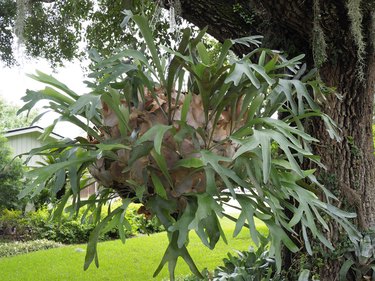
When provided with their preferred growing conditions and care, even novice gardeners will have few staghorn fern problems. Platycerium bifurcatum, hardy in USDA zones 9 through 13, is one of the easiest and most common types grown, although there are 18 recognized species of this fern, along with various hybrids and varieties. Although considered a low-maintenance plant, there are several staghorn pests and diseases that can be problematic.
Characteristics of Staghorn Ferns
Video of the Day
Staghorn ferns are tropical plants that belong in the Polypodiaceae family and grow as epiphytes on tree trunks and branches without harming the tree. They receive all their nutrients and needed moisture through the air and rain. Platycerium bifurcatum, usually called common staghorn fern or elkhorn fern, gets its common name from the foliage resembling a stag's forked antlers.
Video of the Day
The fern has two types of grayish-green leaves, called fronds, that are either foliar or basal. Basal fronds, also known as shields, are flat, sterile, cover the root structure, and are designed to perform their primary job, which is to collect water and nutrients. The foliar type are the showy fronds that resemble stag antlers. Their undersides contain reproductive structures known as sporangia, which are brown and felt-like. Pups develop from the rhizomes, which spread to become a colony of staghorn ferns that can form into a large mass of plants if left undisturbed and not divided.
Diagnosing Staghorn Fern Problems
The main staghorn disease that can cause potential problems is the fungus Rhizoctonia, while pests that might target this fern include scales and mealybugs. Rhizoctonia is a soil-borne fungal disease that causes root and stem rots, leaf blight, and damping-off. On staghorn ferns, it appears as black spots covering the basal leaves. It's primarily problematic in wet and warm conditions and can quickly spread throughout the fern, eventually killing it. Most of the time, the problem occurs due to overwatering and keeping the fern too wet.
Mealybugs and scales are the two main pests that can sometimes infest staghorn fern plants. Mealybugs are white cottony-looking pests with legs, and scales have hard armor-like shell coverings in different colors and, once out of the crawler stage, remain affixed to a portion of the staghorn. Both mealybugs and scales suck the juices out of the staghorn fern's leaves and if populations are severe can eventually kill the plant if left untreated. Snails and slugs can also be a problem if your staghorn fern lies on the ground, but you can easily control snail and slug problems by elevating the fern off the ground where the pests can't get to it.
Treatment and Prevention
To limit the spread of Rhizoctonia, reduce humidity around the plant and withhold water to promote drier conditions. Additionally, you can help prevent the problem by using clean soil and pots. If the condition is persistent, treat the staghorn with a fungicide containing captan, following label instructions on its application and frequency of use. When it comes to good irrigation practices, you can prevent overwatering by allowing the staghorn to begin wilting before watering, which won't harm it. During hot, dry conditions, plan on watering weekly and during the cooler winter months, water every couple of weeks.
When treating mealybug and scale problems, it's safer to use a non-oil-based insecticide to treat the pests than an oil-based one that can damage the foliage. Using an insecticidal soap works to control the mealybugs and scales that are in the crawler or moving stage. Once the scales have found their permanent place on the staghorn and stop moving, they are harder to control. Use a product containing carbaryl and thoroughly cover the infested areas. Always follow label instructions concerning application and frequency of use.